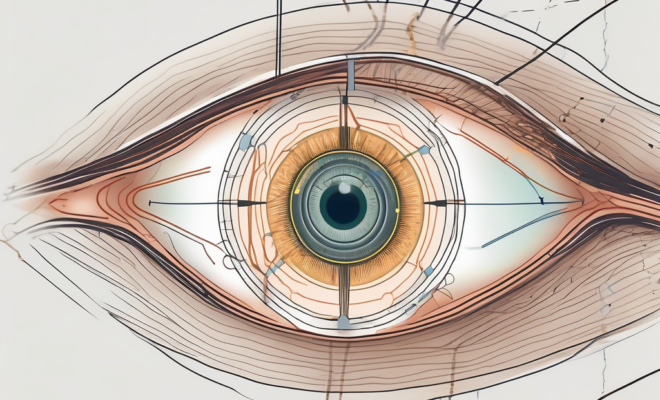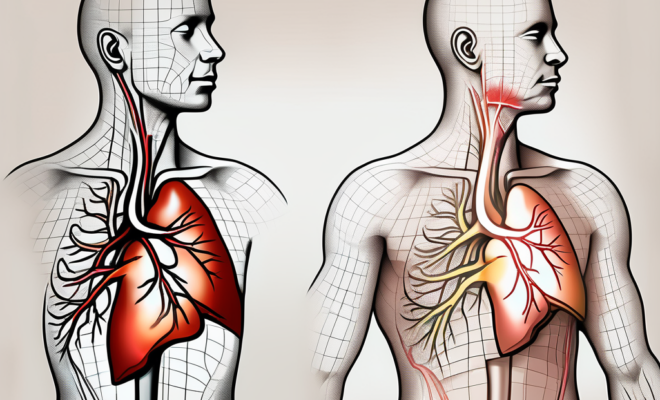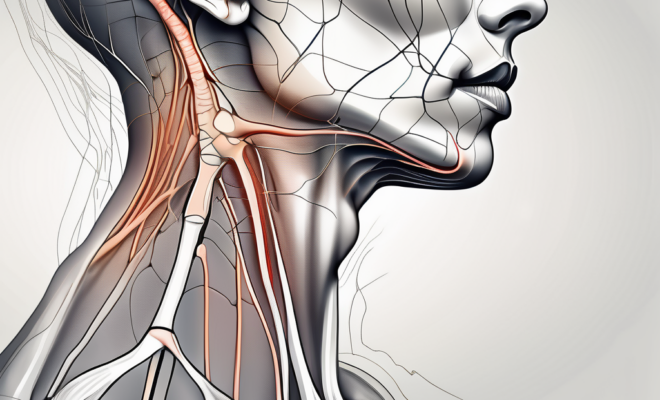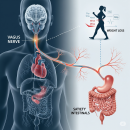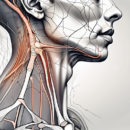Understanding the Role of Sympathetic Nerves in the Body

The human body is a complex system that relies on a multitude of processes to function properly. One such crucial process is the role played by sympathetic nerves in maintaining homeostasis and responding to various stimuli. In this article, we will delve into the intricacies of the nervous system, explore the basics of sympathetic nerves, discuss their functions, and shed light on disorders related to them. Additionally, we will touch upon ongoing research and potential therapeutic applications in the field.
The Basics of the Nervous System
Before we dive into the specifics of sympathetic nerves, it is important to understand the basics of the nervous system. Simply put, the nervous system is a complex network of specialized cells called neurons that facilitate communication throughout the body. These neurons, bundled together, form nerves.
The nervous system is a marvel of biological engineering, playing a crucial role in regulating and coordinating all bodily functions. It is responsible for processing sensory information, initiating motor responses, and enabling higher cognitive functions such as thinking and memory.
Defining the Nervous System
The nervous system can be broadly divided into two main components: the central nervous system (CNS) and the peripheral nervous system (PNS). The CNS consists of the brain and spinal cord, while the PNS includes all other nerves in the body.
The central nervous system, housed within the protective confines of the skull and spinal column, is like the control center of the body. It interprets incoming sensory information, processes thoughts and emotions, and sends out commands to the peripheral nervous system. The peripheral nervous system, in contrast, extends throughout the body like a vast communication network, relaying information back and forth between the CNS and various organs and tissues.
The Central and Peripheral Nervous Systems
The CNS serves as the command center of the body, coordinating and regulating various bodily functions. On the other hand, the PNS acts as a communication pathway between the CNS and the rest of the body.
Within the central nervous system, the brain is a marvel of complexity, with different regions dedicated to specific functions such as motor control, language processing, and memory storage. The spinal cord, an extension of the brain, serves as a conduit for transmitting signals to and from the brain to the rest of the body.
Neurons: The Building Blocks of the Nervous System
Neurons are the structural and functional units of the nervous system. They are responsible for transmitting electrical signals, known as nerve impulses, throughout the body. Neurons consist of a cell body, dendrites that receive signals, and an axon that transmits signals to other neurons.
Neurons come in various shapes and sizes, each adapted to perform specific functions within the nervous system. Some neurons are specialized for rapid signal transmission, allowing for quick reflex responses, while others are involved in more complex processes such as decision-making and problem-solving. Despite their diversity, all neurons work together in harmony to ensure the seamless functioning of the nervous system.
An Overview of Sympathetic Nerves
Sympathetic nerves, also known as the sympathetic nervous system, constitute a crucial part of the Peripheral Nervous System (PNS). They work alongside the parasympathetic nervous system, collectively maintaining a delicate balance within the body known as autonomic regulation. While the parasympathetic nervous system is responsible for promoting rest and digestion, the sympathetic nervous system gears the body up for action and is often associated with the “fight or flight” response.
The sympathetic nervous system is a fascinating network of nerves that plays a vital role in preparing the body for action. When faced with a perceived threat, such as a predator or a stressful situation, the sympathetic nerves kick into high gear, triggering a cascade of physiological responses to help the body respond effectively.
What are Sympathetic Nerves?
Sympathetic nerves, emerging from the thoracic and lumbar regions of the spinal cord, innervate various organs and tissues in the body. They form a complex network that allows for rapid communication and coordination in response to stress or danger.
These nerves release neurotransmitters such as norepinephrine, which act on target organs to increase heart rate, dilate airways, and redirect blood flow to muscles, preparing the body for action. This coordinated response is essential for survival in threatening situations and showcases the intricate design of the sympathetic nervous system.
The Anatomy of Sympathetic Nerves
The sympathetic nervous system consists of a chain of ganglia, which are collections of nerve cell bodies, running alongside the spinal cord. These ganglia enable rapid transmission of signals throughout the body, ensuring a swift response to external stimuli.
Additionally, the sympathetic nerves extend beyond the spinal cord to innervate organs such as the heart, lungs, and digestive system. This widespread network allows for precise control over various bodily functions, highlighting the adaptability and efficiency of the sympathetic nervous system.
The Sympathetic Nervous System and the Autonomic Nervous System
Sympathetic nerves are part of the autonomic nervous system, which controls involuntary bodily functions. The autonomic nervous system is further divided into the sympathetic and parasympathetic systems, each playing a role in maintaining physiological equilibrium.
While the parasympathetic system promotes relaxation and digestion, the sympathetic system readies the body for action, demonstrating the intricate interplay between these two branches of the autonomic nervous system. This balance is crucial for overall health and well-being, showcasing the complexity and sophistication of the body’s regulatory mechanisms.
The Functions of Sympathetic Nerves
The primary function of sympathetic nerves is to prepare the body for action in response to stress or danger. Let us explore the various ways in which they achieve this.
Sympathetic nerves are part of the autonomic nervous system, which controls involuntary bodily functions. These nerves branch out from the spinal cord, extending to various organs and tissues throughout the body. Their role in the ‘fight or flight’ response is crucial for survival, as it allows for rapid and coordinated physiological changes when faced with a threat.
The ‘Fight or Flight’ Response
The well-known “fight or flight” response triggered by sympathetic nerves allows the body to react swiftly to threats. When faced with danger, the sympathetic nervous system activates, dilating the pupils, increasing heart rate, and redirecting blood flow to vital organs, ensuring optimal functioning in critical situations.
Furthermore, sympathetic nerves stimulate the release of adrenaline and noradrenaline, also known as epinephrine and norepinephrine, respectively. These stress hormones enhance alertness, increase energy levels, and sharpen focus, preparing the body to either confront or escape from a perceived danger.
Regulation of Body Functions
Beyond the immediate response to stress, sympathetic nerves also play a role in regulating various body functions. For instance, they control blood pressure by constricting or dilating blood vessels and are involved in temperature regulation by influencing sweat gland activity.
Moreover, sympathetic nerves contribute to the modulation of digestion and urinary function. During times of stress, these nerves inhibit non-essential processes like digestion, redirecting energy to more critical functions such as cardiovascular activity and muscle contraction.
Interaction with Other Body Systems
Sympathetic nerves do not work in isolation; they actively interact with other body systems to maintain overall health and well-being. They communicate with the endocrine system, helping regulate hormone release, and can influence immune responses, impacting the body’s ability to fight off infections.
Additionally, sympathetic nerves are involved in pain perception and modulation. By releasing neurotransmitters such as substance P and calcitonin gene-related peptide, they can either amplify or dampen pain signals, highlighting their role in the body’s response to injury or discomfort.
Disorders Related to Sympathetic Nerves
Like any other system in the body, the sympathetic nervous system can be susceptible to disorders that can significantly impact a person’s quality of life. Let’s explore some of the common disorders, their symptoms, diagnosis, and available treatment options.
Common Disorders of the Sympathetic Nervous System
Disorders affecting the sympathetic nervous system can vary in severity and manifestation. Some well-known conditions include complex regional pain syndrome, autonomic dysfunction, and hyperhidrosis (excessive sweating). These disorders often present with a range of symptoms and can be challenging to diagnose.
Complex regional pain syndrome (CRPS), also known as reflex sympathetic dystrophy, is a chronic pain condition that typically affects one limb, but can spread to other parts of the body. It is characterized by intense pain, swelling, and changes in skin temperature and color. Autonomic dysfunction refers to a disruption in the normal functioning of the autonomic nervous system, which controls involuntary bodily functions such as heart rate, blood pressure, and digestion. This can lead to symptoms like dizziness, fainting, and gastrointestinal issues. Hyperhidrosis, on the other hand, is a condition characterized by excessive sweating, even in the absence of physical exertion or high temperatures.
Symptoms and Diagnosis of Sympathetic Nerve Disorders
Symptoms of sympathetic nerve disorders can include abnormal sweating, temperature fluctuations, increased heart rate, and blood pressure irregularities. However, the presentation of symptoms can vary depending on the specific disorder. For example, individuals with CRPS may experience burning pain, muscle spasms, and sensitivity to touch, while those with autonomic dysfunction may have symptoms like dry eyes, urinary problems, and difficulty regulating body temperature.
Diagnosis usually involves a thorough medical history review, physical examination, and, in some cases, specialized tests such as autonomic function tests. These tests measure the body’s response to various stimuli and can help identify any abnormalities in the sympathetic nervous system. Additionally, imaging studies like X-rays, MRI, or CT scans may be used to rule out other possible causes of symptoms.
Treatment and Management of Sympathetic Nerve Disorders
While there is no cure for many sympathetic nerve disorders, various treatment options aim to manage symptoms and improve quality of life. Medications such as pain relievers, antidepressants, and anticonvulsants may be prescribed to alleviate pain and manage associated symptoms. Physical therapy can help improve mobility, reduce muscle stiffness, and increase overall function.
In some cases, nerve blocks may be recommended to temporarily interrupt the pain signals transmitted by the sympathetic nerves. These blocks involve injecting an anesthetic or medication directly into the affected nerve or nerves. Additionally, lifestyle modifications such as stress management techniques, regular exercise, and a healthy diet can play a crucial role in symptom management.
It is crucial for individuals with these disorders to work closely with healthcare professionals to develop an individualized treatment plan. This may involve a multidisciplinary approach, with input from pain specialists, neurologists, physical therapists, and psychologists. Regular follow-up appointments and open communication with the healthcare team are essential to monitor progress, adjust treatment as needed, and provide ongoing support.
The Future of Sympathetic Nerve Research
The field of sympathetic nerve research is ever-evolving, with ongoing studies continuously uncovering new insights into the function and potential therapeutic applications of sympathetic nerves. Let us explore some current research trends and the potential impact of advancements in neurology.
Current Research Trends
Researchers are investigating various areas related to sympathetic nerves, ranging from understanding the molecular mechanisms underlying their function to exploring potential therapeutic targets. For example, recent studies have focused on the role of sympathetic nerves in regulating immune responses and inflammation. By understanding how sympathetic nerves interact with the immune system, researchers hope to develop new treatments for autoimmune diseases and chronic inflammatory conditions.
Advancements in imaging techniques and genetic studies provide exciting opportunities for further discoveries in sympathetic nerve research. High-resolution imaging technologies, such as confocal microscopy and electron microscopy, allow researchers to visualize sympathetic nerve fibers in unprecedented detail. This enables them to study the intricate connections between sympathetic nerves and their target organs, leading to a better understanding of how these nerves influence various physiological processes.
Potential Therapeutic Applications
The expanding knowledge in sympathetic nerve research opens up promising avenues for potential therapeutic applications. It is conceivable that future treatments could target sympathetic nerve pathways to modulate physiological responses in conditions such as hypertension, chronic pain, and autonomic dysfunction. For instance, researchers are exploring the use of neuromodulation techniques, such as spinal cord stimulation and deep brain stimulation, to selectively modulate sympathetic nerve activity and alleviate symptoms in patients with these conditions.
Furthermore, recent studies have highlighted the potential role of sympathetic nerves in metabolic disorders, such as obesity and diabetes. By understanding how sympathetic nerves regulate energy balance and glucose metabolism, researchers aim to develop novel therapeutic strategies for managing these conditions. This could involve targeting specific receptors or signaling pathways within sympathetic nerves to restore metabolic homeostasis.
The Impact of Advancements in Neurology
Advancements in neurology have far-reaching implications, not only in the realm of sympathetic nerve research but also in understanding and treating a myriad of other neurological conditions. As technology advances, our understanding of the nervous system expands, paving the way for novel diagnostic tools and more effective treatments.
For example, the development of non-invasive brain imaging techniques, such as functional magnetic resonance imaging (fMRI) and positron emission tomography (PET), has revolutionized our ability to study brain function in real-time. This has led to significant advancements in our understanding of how sympathetic nerves interact with the brain and influence cognitive processes, emotions, and behavior. Such insights could have profound implications for the development of targeted therapies for psychiatric disorders and neurodegenerative diseases.
Furthermore, advancements in neuroengineering and neuroprosthetics hold great promise for individuals with sympathetic nerve-related disorders. Researchers are exploring the use of bioelectronic devices, such as nerve stimulators and neural interfaces, to restore or modulate sympathetic nerve activity in patients with conditions like heart failure or bladder dysfunction. These innovative technologies have the potential to significantly improve patients’ quality of life and functional outcomes.
In conclusion, sympathetic nerves play a crucial role in maintaining bodily homeostasis and responding to external stimuli. Their functions extend beyond the well-known “fight or flight” response, encompassing the regulation of various bodily processes. Ongoing research in the field continues to shed light on the intricacies of sympathetic nerve function, raising the prospect of potential therapeutic applications. As the field of neurology advances, we can look forward to a deeper understanding of the nervous system and improved treatments for various conditions.



